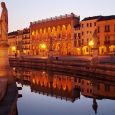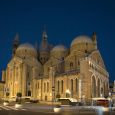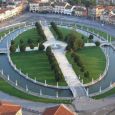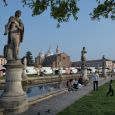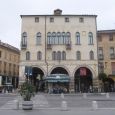Padua
Advertisement
By Air
Padua is relatively close to airports at Venice, Verona, Treviso and Bologna.The Padua airport, the "Gino Allegri" or Aeroporto civile di Padova "Gino Allegri", or Aeroporto di Padova, is no longer served by regularly scheduled flights.Padua is, however, the home of one of Italy's four Area Control Centers.Venice, approximately 50 km away, is the nearest seaport.
By Train
Padua has two train stations opened to the passenger service, named after the city. The station has 11 platforms and sometimes is incorrectly referred to as "Padova Centrale"; it is one of the biggest stations in Italy. More than 450 trains per day leave Padova. The station is used by over 20 millions passengers per year. Other train stations are Padova Ponte di Brenta (soon to be closed), Padova San Lazzaro (planned), Padova Campo di Marte, with no passenger service once used as a freight station which could become one of the stations of the "Servizio Ferroviario Metropolitano Regionale". From Padova, high speed trains connect to Milan, Rome, Bologna, Florence and Venice; one can reach Milan in 1h and 51 min, Rome in 3 hours and 20 min and Venice in 20 min.The station was opened in 1842 when the service started on the first part of the Venice-Milan line (the "Imperial Regia Ferrovia Ferdinandea") built from Padua to Marghera through Mestre. Porta Marghera is a major port of the Venetian area.Railways enthusiasts can visit the Signal Box A (Cabina A), preserved by the "Società Veneta Ferrovie" (a society named after the former public works and railway company, based in "Piazza Eremitani" in Padua) association.
By Car
there are 3 motorways A4 Brescia-Padova, connecting it to Verona (then to Brenner Pass, Innsbruck and Bavaria) and Milan (then Switzerland, Turin and France); A4 Padova-Venezia, to Venice then Belluno (for Dolomites holiday resorts like Cortina) Trieste and Tarvisio (for Austria, Slovenia, Croatia and Eastern Europe); A13 Bologna-Padova, to Ferrara and Bologna (then Central and South Italy). You have to pay a toll to use most of the Italian motorways. Roads connect Padua with all the large and small centers of the region. A freeway with more than 20 exits surrounds the city, connecting districts and the small towns of the surrounding region.
Scrovegni Chapel
is a church in Padua, Veneto, Italy.It contains a fresco cycle by Giotto, completed about 1305, that is one of the most important masterpieces of Western art.The church was dedicated to Santa Maria della Carita at the Feast of the Annunciation, 1305.Giotto's fresco cycle focuses on the life of the Virgin Mary and celebrates her role in human salvation.The chapel is also known as the Arena Chapel because it was built on land purchased by Enrico Scrovegni that abutted the site of a Roman arena.This space is where an open-air procession and sacred representation of the Annunciation to the Virgin had been played out for a generation before the chapel was built.A motet by Marchetto da Padova appears to have been composed for the dedication on March 25, 1305.One of the most gripping paintings in the chapel is Giotto's portrayal of The Kiss of Judas, the moment of betrayal that represents the first step on Jesus' road to the Crucifixion.
Palazzo della Ragione
is a Medieval town hall building in Padua, in the Veneto region of Italy.The building, with its great hall on the upper floor, is reputed to have the largest roof unsupported by columns in Europe; the hall is nearly rectangular, its length 81.5m, its breadth 27m, and its height 24 m; the walls are covered with allegorical frescoes; the building stands upon arches, and the upper storey is surrounded by an open loggia, not unlike that which surrounds the basilica of Vicenza.The Palazzo was begun in 1172 and finished in 1219. In 1306, Fra Giovanni, an Augustinian friar, covered the whole with one roof; originally there were three roofs, spanning the three chambers into which the hall was at first divided; the internal partition walls remained till the fire of 1420, when the Venetian architects who undertook the restoration removed them, throwing all three spaces into one and forming the present great hall, the Salone. The new space was refrescoed by Nicolò Miretto and Stefano da Ferrara, working from 1425 to 1440.A tornado destroyed the roof and damaged the building on 17 August 1756.
Basilica of Saint Anthony of Padua
is a Roman Catholic church and minor basilica in Padua, northern Italy. Although the Basilica is visited as a place of pilgrimage by people from all over the world, it is not the titular cathedral of the city, a title belonging to the Cathedral-Basilica of St. Mary of Padua. The basilica is known locally as "il Santo".Construction of the Basilica probably began around 1232, just one year after the death of St. Anthony. It was completed in 1301 although several structural modifications (including the falling of the ambulatory and the construction of a new choir screen) took place between the end of the 14th and the mid 15th century. The Saint, according to his will, had been buried in the small church of Santa Maria Mater Domini, probably dating from the late 12th century and near which a convent was founded by him in 1229. This church was incorporated into the present basilica as the Cappella della Madonna Mora (Chapel of the Dark Madonna).
Museum of Precinema
is a museum in the Palazzo Angeli, Prato della Valle, Padua, Italy, related to the history of precinema, or precursors of film. It was created in 1998 to display the Minici Zotti Collection, in collaboration with the Comune di Padova. It also produces interactive touring exhibitions and makes valuable loans to other prestigious exhibitions such as 'Lanterne magique et film peint' at the Cinématèque Française in Paris and the Museum of Cinema in Turin.The museum is housed on the top floor of the 15th-century Palazzo Angeli. In the 18th century, the building was home to Andrea Memmo, adviser and attorney to the Republic of Venice. He was also the benefactor of Padua responsible for transforming the marshy wasteland of Prato della Valle into a monumental piazza and the largest square in Italy. His friend Giacomo Casanova was once a guest at the Palazzo Angeli, and it was from the viewpoint of the building's windows that Canaletto etched his panoramic view of the Prato in the mid-eighteenth century using a camera obscura.
Pedrocchi Cafe
is one of the biggest cafes in the world, included in a 19th century building in the centre of Padua, northern Italy. Its rooms are decorated in various styles and show the great ecleptism of Giuseppe Jappelli, the architect who designed the building.The cafe is historically known for having been the centre of the 1848 riots in Padua as well as for having been and for being still nowadays the meeting point of great artists such as the French novelist Stendhal, the English poet Lord Byron, the Italian Nobel prize winner Dario Fo.
July - October
December - May


